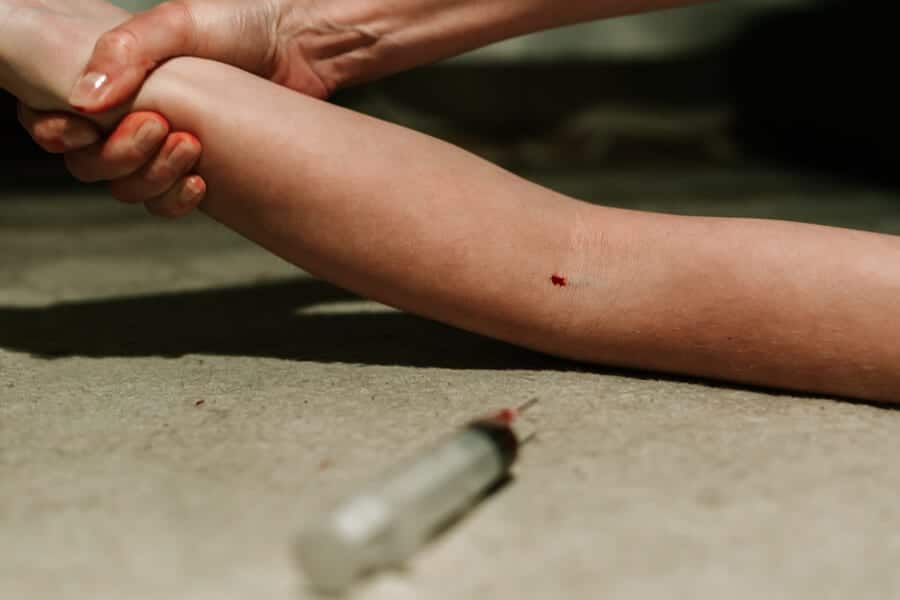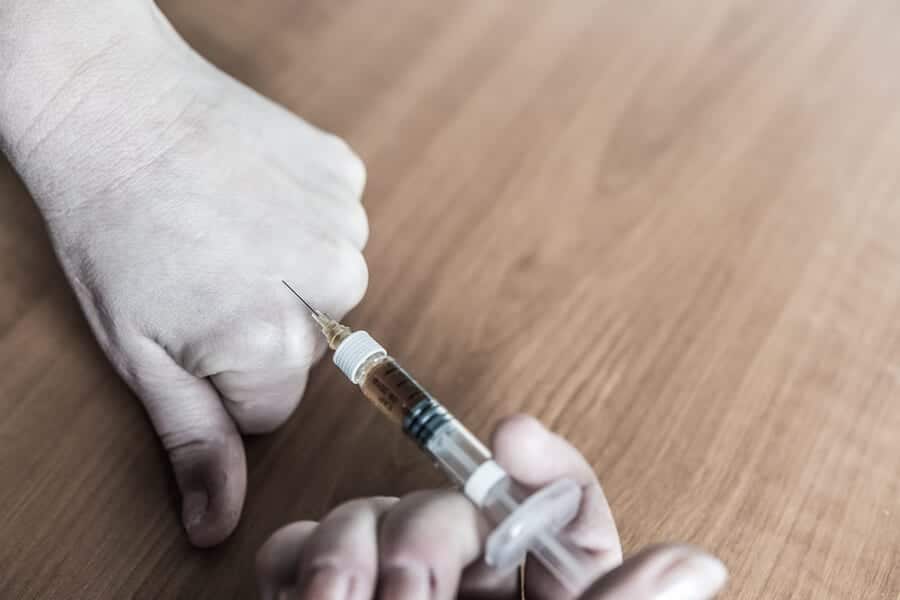
Track Marks on the arms are often a tell-tale sign of heroin use. Heroin is an illicit opioid derived from morphine, an alkaloid found in the poppy plant. When injected, skin lesions known as “track marks” are often visible on a user’s arms, legs, and sometimes other areas of the body.
The Risks of Heroin Use
Heroin is an incredibly addictive drug, and its abuse has consequences that reach far beyond the user’s emotional and physical health. There may be virtually endless repercussions, and heroin tends to wreak more havoc than many other drugs of abuse.
A number of significant health risks come with heroin use. Many heroin users inject the drug. Those who share needles expose themselves to the possibility of contracting a number of infectious diseases, including Hepatitis-C and HIV. Due to a scarcity of syringes, users often use the same one several times. This results in a dull point and increased risk of skin infection.
People who are dependent on heroin often become completely preoccupied with their using and withdrawal cycle. This leads to difficulties in the following life areas:
- Social life. Heroin users usually become increasingly isolated as their addiction deepens.
- Legal ramifications. Opioid addiction often leads users to a variety of legal troubles. These can range from simple civil law suits to felony possession and distribution charges.
- Financial issues. Opioid addicts have no choice but to score nearly every day. This creates incredible financial difficulties very quickly.
- Mental health difficulties. Long term heroin use damages the white matter in the brain. This can lead to cognitive difficulties and poor decision making. A variety of physical and psychosocial factors push heroin users into deep states of depression.
This list of difficulties is far from complete. If you or someone you care about is dependent on heroin, please seek help immediately.
Easy Access and The Opioid Crisis
Heroin use has increased dramatically over the last several years. Many people believe that this stems from the practices of pharmaceutical companies and over prescribing. prescribing of opioids that began two decades ago. These drug manufacturers, such as the makers of OxyContin, marketed their products in a misleading fashion. They insisted their products were not addictive, and physicians seemed to believe them.
As a result of OxyContin’s widespread accessibility, many became dependent on it. Eventually, these patients could no longer afford OxyContin and turned to using heroin instead. This happened because the street drug is cheaper and relatively easy to acquire.
Unfortunately, the drug cartels saw this coming. They realized that the increase in opioid addiction in the U.S. would also increase demand, so they responded with producing, trafficking, and distributing more heroin in the U.S.
Regardless of how heroin is ingested, regular users often encounter an array of medical problems that can become severe. Those who use heroin intravenously, however, face a unique set of challenges as injection sites increase, must be reused, and skin sores and damage to veins continue to accumulate over time.
What Are Track Marks?
Track marks occur when a user injects heroin into a vein—known as “shooting up.” Any iv drug user can develop these tell-tale signs of shooting up, but injection is particularly common among people who use heroin. Medical issues with injection sites can become very serious and have the potential to result in amputation or even death.
These marks develop when a user injects drugs at the same sites multiple times. When a mark is fresh, it will appear as a raw and slightly bloody inflamed area. Some resemble puncture wounds. Older track marks will often be discolored and calloused and may present with abscesses and pus.

Heroin users typically develop this type of scar tissue on their arms, largely because they’re easiest to reach. They are most often found in the inside crook of the elbow, not unlike receiving a shot at a doctor’s office. The scar tissue over arm injection sites may be located near a large vein on the back of a user’s hand or wrist as well.
Track marks on legs are commonly found on the inner thigh, and some users will inject into large veins on their feet. Injections often become more and more difficult and painful as some veins and sites are rendered useless, and the person is then forced to inject in other places around the body. The average iv drug user will start to change injection sites as they learn more about using the drug.
If heroin use continues beyond this point, some users will inject between their toes, and eventually into their forehead, neck, chest, and whatever place they can find available. Once a user has progressed to this point, their condition is clearly very severe, and they are at a high risk of irreversible damage to their body and death.
Many heroin users will go to great lengths to conceal their drug use and track marks. Makeup or bandaids might work in mild cases, but as the problem becomes worse, they may be forced to wear long sleeves and pants, even in warm weather, as a means to cover the destruction they have caused to their bodies.
Of note, track marks are not always an indication of current drug use. Many reused injection sites can become long-lasting scars that do not fade well without help from cosmetic surgery. And, unfortunately, this is an elective surgery that may be cost-prohibitive and not covered by insurance.
Why They Appear
Track marks appear bruised because blood may leak out of a vein that has been injected. The darkening of veins is due to scarring and the buildup of toxins. Also, arterial damage can occur at the site of injections, which can rupture and result in hemorrhage, gangrene, or ischemia (restriction of blood supply to tissues).
Repeatedly injecting heroin into the same site is ultimately going to cause scarring of surface veins. This will cause the vein to collapse eventually if the abuse continues long enough. Another significant disadvantage of injecting heroin is that users often do not sanitize injection sites. This lack of personal protection puts them at an increased risk of developing cellulitis and thrombophlebitis.
One of the most common and severe effects of chronic IV drug use is the development of collapsed veins. As damage occurs to the lining of veins, blood clots can form. Multiple uses of blunt needles, repeated use of the same injection site, or improper injection technique can cause the vein to become blocked completely.
The Development of Addiction

Injecting heroin results in a rapid and intense release of the drug into the brain, and therefore has a higher potential for causing addiction than, say, smoking or snorting. For this reason and others, many experts believe heroin to be the most addictive and dangerous drug in the world.
Repeated heroin use often leads to the development of tolerance, a condition that forces a person to use ever-increasing amounts of the drug to experience the desired effects. If use continues to escalate, users put themselves at a higher and higher risk of overdose.
Another component of a burgeoning addiction is dependence. Dependence can be both chemical and psychological and occurs as the body and mind adapt to a drug’s presence, becoming unable to function correctly without it. When a user tries to quit or cut back, he or she will then encounter highly unpleasant withdrawal symptoms that are often the catalyst for a return to regular drug use.
Finally, the last component of addiction is compulsive drug-seeking behavior despite the negative consequences their drug use causes. At this point, a person will likely do almost anything to obtain and use their drug of choice, and they may resort to borrowing money or stealing items from others—prostitution and other crimes are not uncommon.
Getting Treatment for Heroin Addiction
From detox to intensive treatment to aftercare, Harmony Recovery Center offers a full continuum of care for people struggling with drug addiction. Our health providers and highly-trained addiction specialists will guide you or your loved one step-by-step, one day at a time toward long-lasting sobriety and wellness.
Services we offer include, but are not limited to, the following:
- Outpatient detox
- Partial hospitalization programs
- Intensive outpatient and outpatient programs
- Peer support groups
- Individual and family counseling
- Holistic practices such as yoga and medication
- Experiential activities such as art and music therapy
- Health and wellness education
- Substance abuse education
- Aftercare planning
Track marks are a sign of impending tragedy. If you or someone you care about is struggling to overcome a dependence on heroin, it can feel like being trapped, hopeless, and helpless, with no way out. Call us today and discover how we help those who need it most break the chains of addiction for life!